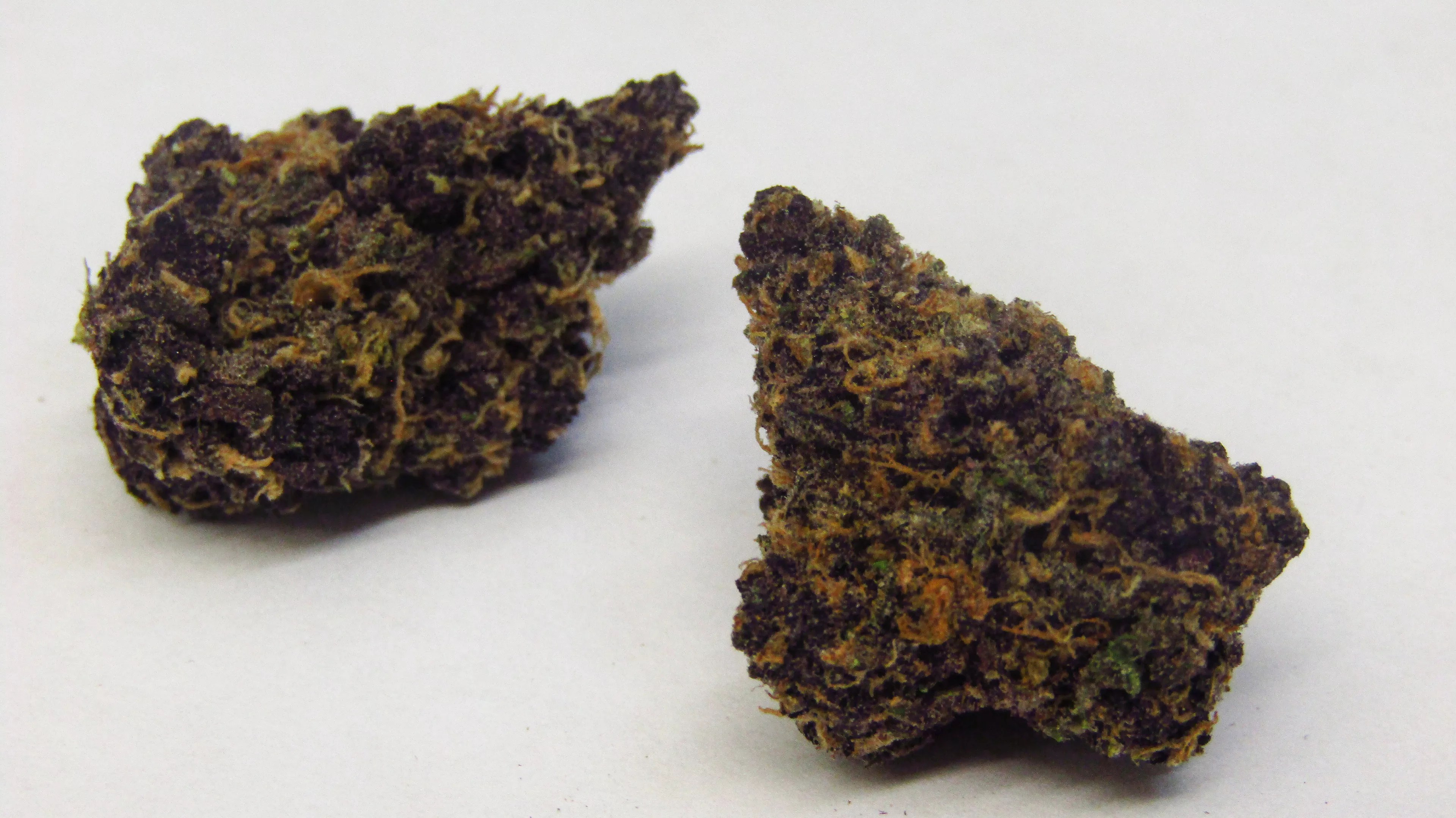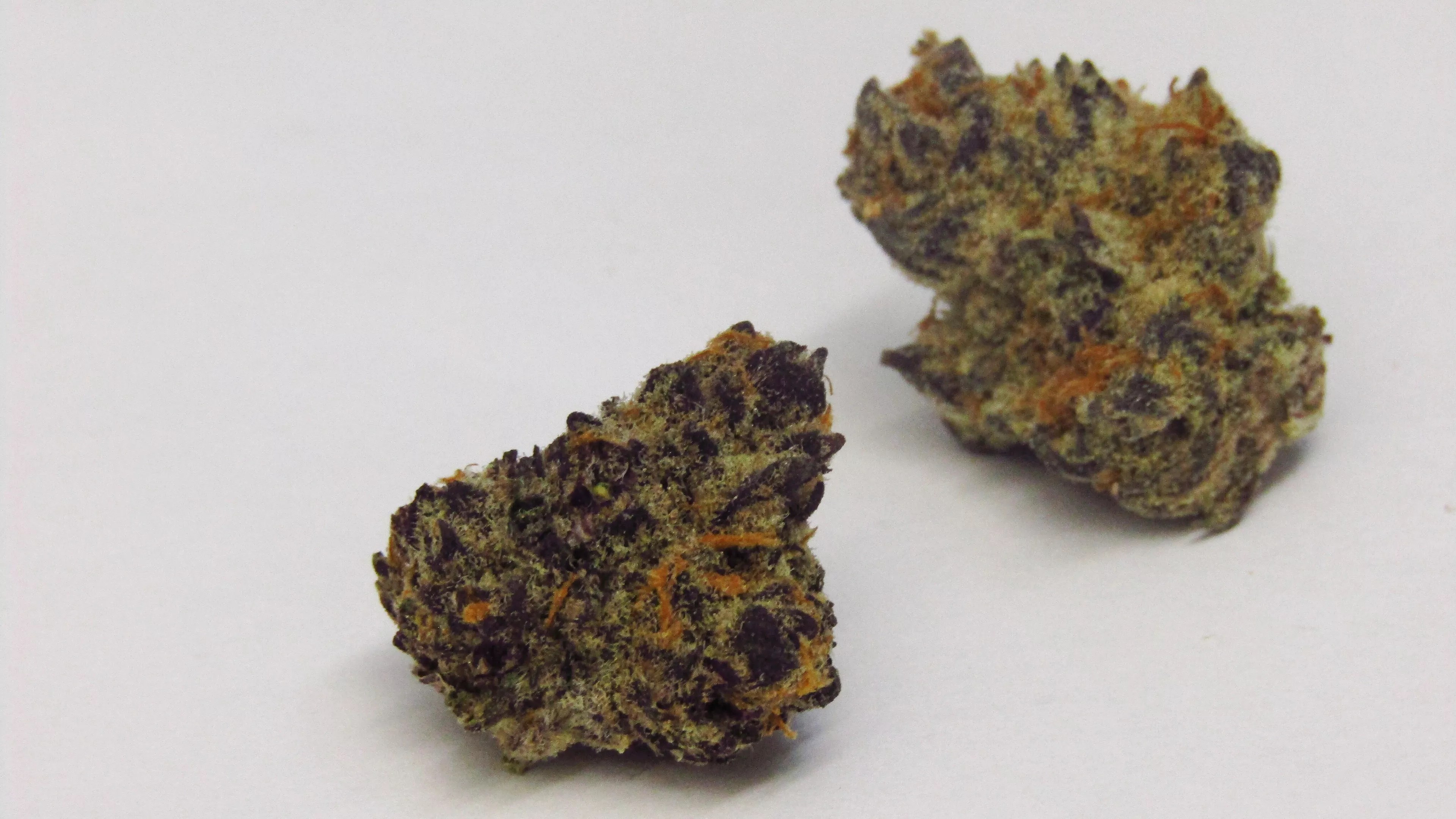
Herbert Fuego

Audio By Carbonatix
Like a crisscross grill mark on a prime cut of beef, purple cannabis tends to be overvalued by our eyes. Does it look cool? Absolutely. Does it really improve the experience, though?
The qualities typically associated with purple cannabis – grape flavors and sedative and potent effects – can easily be achieved with regular ol’ green pot. On the flip side, there’s plenty of purple weed out there that carries uplifting highs and non-fruity flavors. But those realities disappear when you look at a gleaming purple bud covered in trichomes and orange hairs: Smoking a sunset is fun.
Purple pot’s place in our hearts will never go away, but the strain names do. To give the classics some love and highlight new mauve marijuana varieties, here are our inaugural Purp Power Rankings:
Cherry Hills
Who would’ve thought that a high-CBD strain would take the top spot? There’s no denying how striking Cherry Hills looks once you see the pure violet darkness covering these buds, though, especially in a large dispensary jar. A cross of Appalachia, Cherry Pie and Grand Daddy Purple, Cherry Hills was bred by ThugPug Genetics, which may have created one of the most purple strains I’ve ever seen. (A completely different strain called Cherry Hill, a mix of ACDC and Cherry Kandahar, is also known for a deep-purple color and high CBD content. However, Cherry Hill has a 1:24 THC to CBD ratio, while the Cherry Hills ratio is closer to 2:1.)
Denver, make your New Year’s Resolution Count!
We’re $10,000 away from reaching our $50,000 year-end fundraising goal. Your support could be what pushes us over the top. If our work has kept you informed and connected this year, please consider making a contribution today.
Purple Haze
Jimi Hendrix’s song “Purple Haze” isn’t actually about purple weed, but street acid. (Look at the leafy nugs people smoked in the ’60s, and it will make more sense.) Still, the lyrics were close enough to help make Purple Haze one of the most popular, if not the most popular, purple strains of all time. The legend of Purple Haze was born before its genetic profile was, but the most agreed-upon lineage traces it back to Purple Thai, an old landrace strain. You might find better or more attainable strains – hell, you might not find Purple Haze at all on a given day – but our affinity for purps wouldn’t be what it is without Purple Haze.
Grape Pie
Turns out Concord grape pies are actually a thing, baked mostly in western New York and parts of Pennsylvania. But in progressive Denver, Grape Pie bakes you. A heavy indica-leaning hybrid of Cherry Pie and Grape Stomper, Grape Pie offers sweet, doughy flavors similar to Cookies variants, but with a syrupy-grape addition. The strain has been popular in California and Colorado since its introduction a couple of years ago from breeders like the Jungle Boys and Cannarado Genetics.
Purple Kush
We could name mauve marijuana varieties for a while, but few are more important than Purple Kush. This mix of Hindu Kush and Purple Afghani is sweet, earthy and never grows old, with a high meant for a relaxing night in. Purple Kush is still sold in dispensaries today, even if it’s not as attainable as it was a few years ago.
Grand Daddy Purple
Literally the granddaddy of them all, at least by name. Anyone who began smoking cannabis in the late 2000s or early 2010s is very familiar with Grand Daddy Purp, or its alter ego, GDP. Before Grape Pie or Greasy Grapes showed up, we had this. Although modern growing preferences have pushed one foot out the door for Grand Daddy Purp, its influence is still heavily felt today. Much like its parent strain Mendocino Purps, Grand Daddy Purp is a popular stud and has a large family tree of more modern strains.

Purple Punch
Herbert Fuego
Purple Punch
A child of Grand Daddy Purple and Larry OG, Purple Punch’s potential to create amazing hash has made the sedative strain a hit among regular users, while its dense, violet buds draw in excited newbs like flies to a bug zapper – and then fries them the same way. Like most strains with syrupy grape aromas and purple buds, Purple Punch is best enjoyed at night. Treat it like a spiked beverage bowl of sweet disaster at a high school dance, or you’ll be face-first on the ground.
Grape Cream Cake
This mix of Grape Pie, Ice Cream Cake and Wedding Crasher is being pushed by over a dozen Colorado growers and extractors right now, with each version delivering a different mix of grape gasoline and sweet cream aromas. Some are more purple than others, but every version I’ve tried has been extremely powerful under the eyes, and ultimately provides a relaxing, stress-killing high.
Grape Ape
Grape Ape has become more of a reputation than a strain, sadly. Nowadays, Grape Ape is sold in the forms of cheeky food and merchandise names – although the Grape Ape doughnut at Voodoo Doughnut is a revelation – and the strain itself is only found sparingly at Denver dispensaries. Even if it’s not 2015 any more, Grape Ape still deserves respect for the run it had. Hopefully it makes a return as breeders become more magical with their genetic crossing.
Grape Soda
Grape Soda has an OG Kush lineage known more for making your head float than an afternoon sugar rush. A select phenotype of Tahoe OG Kush (itself a phenotype of OG Kush) that was then possibly paired with another mystery strain, Grape Soda became popular in the Northwest after a successful competition run in 2017, and has since made headway in Colorado. Although I gravitate to Grape Soda extractions more than the flower itself, the strain’s artificial grape flavor is second to none.
Burkle
Burkle became popular in Colorado about five years ago, and the strain’s consistently violet color and tranquilizing effects have kept it on dispensary shelves. But then, it’s hard to imagine any downside to a strain bred from a cross of Grand Daddy Purple and pre-’98 Bubba Kush. Nearly everything about Burkle’s smell and appearance says you’re about to get blitzed by the entire legion of boom. Dark, sticky buds and notes of Kush, berries and zesty licorice on the nose are essentially the bright colors of a poisonous tree frog, warning any toker brave enough to get close that a quick end to their day is coming.